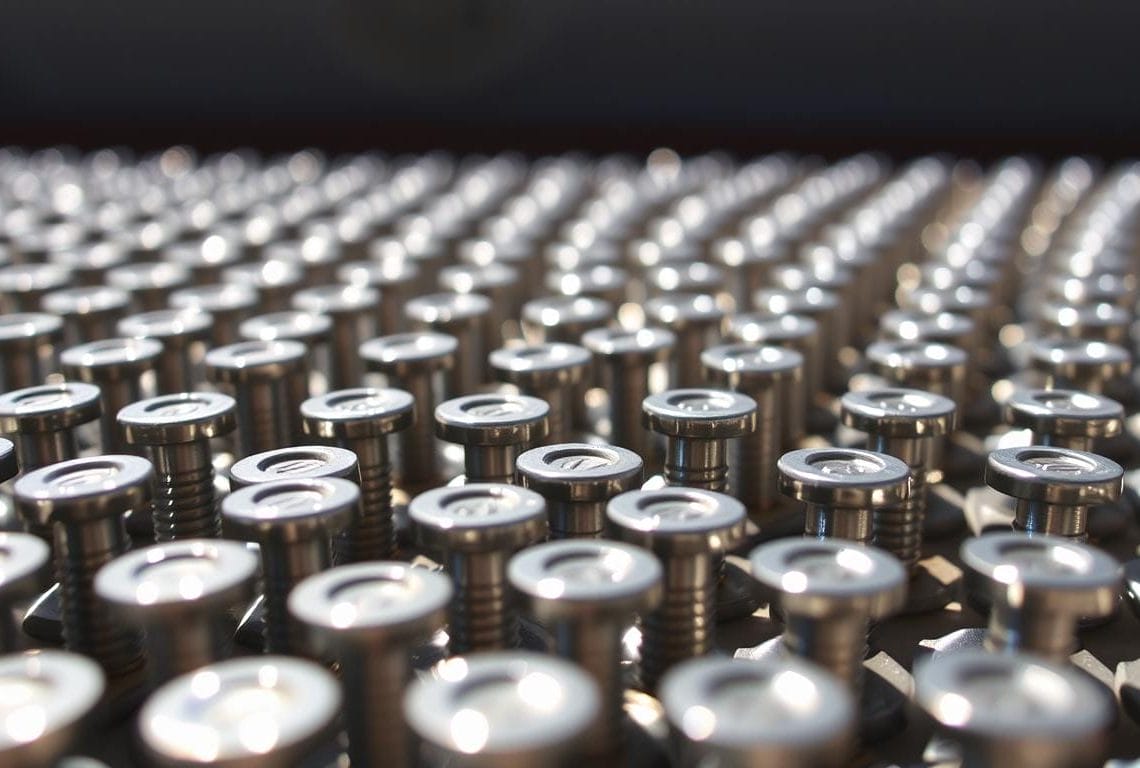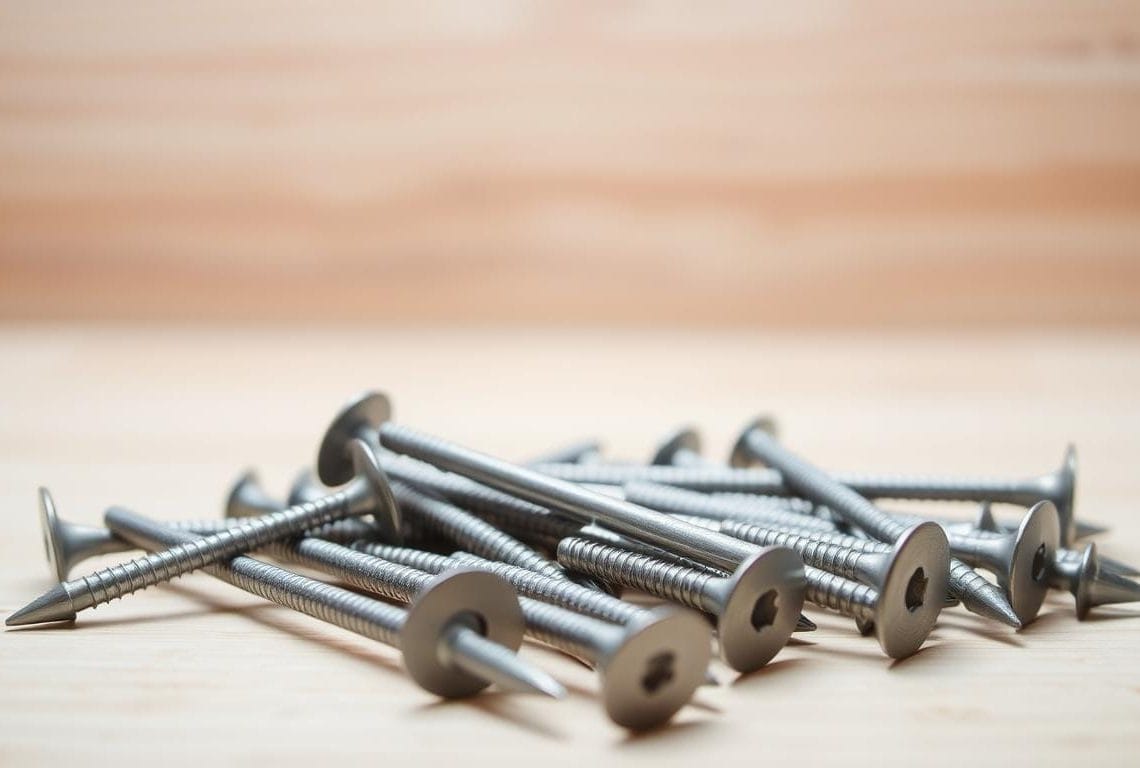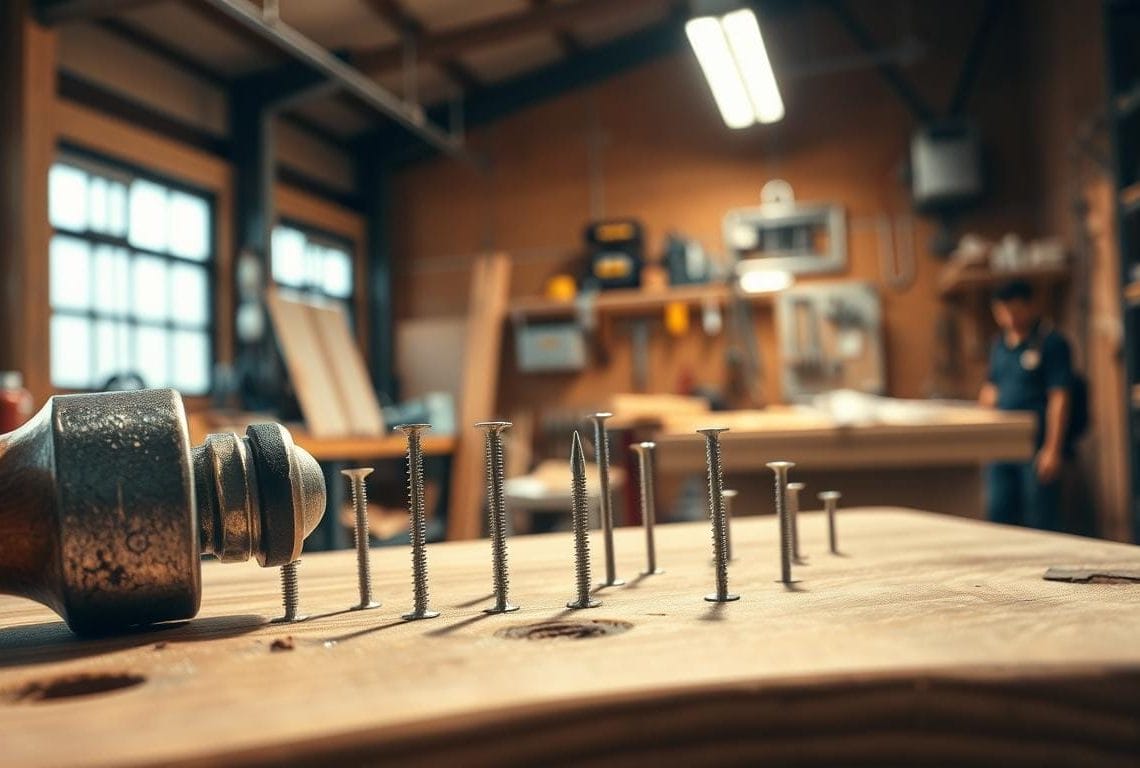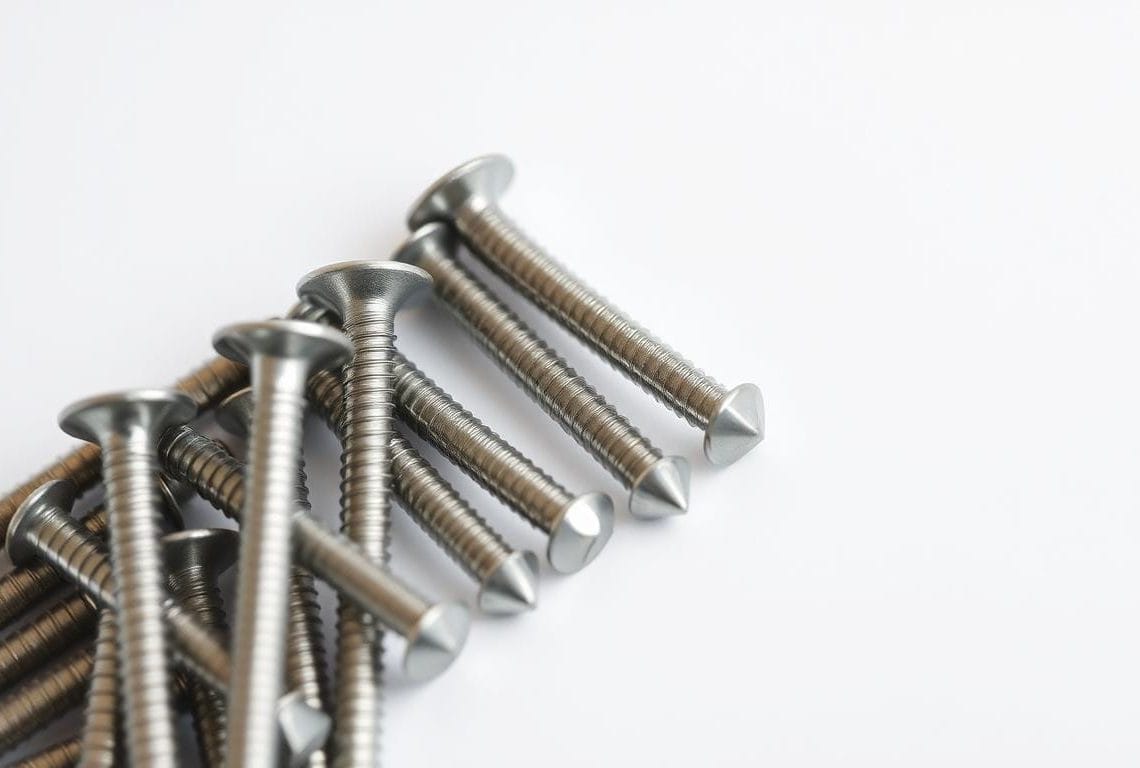Did you know stainless steel nails can last decades without rust? They are key in outdoor construction. This is because they resist corrosion well, thanks to nickel and chromium. They’re perfect for harsh environments, lasting longer than other nails.
Stainless steel nails, like 304 and 316 fasteners, resist rust well. Stainless steel 304 works best in dry places. But, stainless steel 316 is better for humid or coastal areas.
Using stainless steel nails can make a structure last longer. This means less need for repairs and replacements. They’re a smart choice for projects needing durable nails.
Understanding Stainless Steel Nails and Their Composition
Stainless steel nails are key in many construction projects. They stand up well to corrosion. This makes them perfect for outdoor and marine use. The mix of steel, chromium, and sometimes nickel or molybdenum gives them great rust and corrosion resistance.
The type of stainless steel used affects the nails’ composition. Grades like 304 and 316 are common. The steel is shaped and cut to make strong, durable nails.
Chemical Composition of Stainless Steel Nails
The mix of elements in stainless steel nails is key to their corrosion fight. Chromium, nickel, and molybdenum help them face corrosive environments. Here’s what each element does:
- Chromium: fights corrosion and oxidation
- Nickel: makes the nail flexible and resistant to corrosion
- Molybdenum: boosts the nail’s strength and corrosion resistance
Different Grades of Stainless Steel Used
Stainless steel nails come in different grades. Each has its own mix and properties. Grades 304 and 316 are the most common. They’re great for many uses because of their corrosion resistance.
Manufacturing Process Overview
Making stainless steel nails involves drawing, cutting, and shaping the steel. It’s a detailed process to ensure quality and durability. Stainless steel fasteners, like nails, are a reliable choice for construction projects.
The Superior Rust-Resistance Properties of Stainless Steel Fasteners
Stainless steel fasteners, like corrosion resistant nails, are better at fighting rust than other materials. This is because they have a lot of chromium, which helps protect them from rust. So, stainless steel hardware is perfect for outdoor projects, where they face the weather.
Outdoor stainless nails are great for coastal areas, where salt can cause rust. Using stainless steel fasteners here can cut down on maintenance costs by half. Also, most stainless steel fasteners have a tensile strength over 70,000 PSI, making them strong for tough jobs.
Some key benefits of stainless steel fasteners include:
- They resist corrosion better than carbon steel fasteners
- They last longer in harsh environments (over 10 years)
- They save on maintenance costs
- They have high tensile strength (over 70,000 PSI)
In summary, stainless steel fasteners are a top choice for outdoor projects, like those in coastal areas. Their ability to resist rust makes them a reliable option.
Common Types and Sizes of Stainless Steel Nails
Stainless steel nails come in many types and sizes for different uses. It’s key to pick the right nails for your project. This includes thinking about the material and the environment. High quality steel nails help make structures last longer.
For details like trim and molding, stainless steel finish nails are best. They are thin and hide well in wood. But, for outdoor jobs like roofing and siding, thicker stainless steel nails are better. They hold strong.
Finish Nails and Brad Nails
Finish nails and brad nails are for finishing touches. They come in different lengths. Made from high quality steel, they hold well without damaging wood. Stainless steel finish nails are great for projects needing to resist corrosion.
Roofing and Siding Nails
Roofing and siding nails are for outdoor work. They include ring shank nails and galvanized nails. Stainless steel nails are top picks for their resistance to corrosion and durability.
- Ring shank nails provide increased holding power
- Galvanized nails offer protection against rust
- Stainless steel nails are ideal for projects that require a high level of corrosion resistance
Applications in Outdoor Construction Projects
Stainless steel nails are a top choice for outdoor projects. They resist rust and corrosion well. This makes them perfect for decking, fencing, and roofing. Outdoor stainless nails last long and are very durable.
In outdoor projects, durable stainless nails are key. They handle harsh weather and last for years. They’re great for coastal areas where moisture is high.
Some common uses for stainless steel nails are:
- Decking and fencing
- Roofing and siding
- Trim work and other exterior finishes
The design and coating of outdoor stainless nails matter a lot. For example, a coated finish can protect against corrosion. When picking durable stainless nails, think about the project’s needs and the environment.
Using stainless steel construction nails makes structures durable and long-lasting. They’re vital for decks, fences, and roofs. Durable stainless nails are a must for any outdoor project.
Marine Environment Usage and Benefits
Stainless steel fasteners are a top choice for marine environments because they resist corrosion well. They are used in coastal projects like docks and seawalls. This helps prevent rust and corrosion.
Using stainless steel hardware in these areas is crucial. It protects against saltwater, humidity, and storms. These elements can damage materials quickly.
Stainless steel fasteners are great for marine settings. They can handle tough conditions without needing constant checks and fixes. This saves money on labor and materials over time. Corrosion resistant nails are also key in coastal projects, where corrosion is a big risk.
Stainless steel fasteners also have high tensile strength. This makes them perfect for marine uses like boat building and dock construction. Using stainless steel fasteners ensures these structures last longer and stay safe.
The main advantages of stainless steel fasteners in marine settings include:
- Corrosion resistance
- High tensile strength
- Low maintenance costs
- Long lifespan
In summary, stainless steel fasteners bring many benefits to marine environments. They resist corrosion and have high tensile strength. By picking the right stainless steel fastener for your project, you can make sure your structure lasts and stays safe.
Comparing Stainless Steel Nails to Other Materials
Choosing the right nails for construction projects is crucial. Stainless steel nails are a top pick because they resist corrosion well. They outperform materials like galvanized steel and aluminum in terms of durability and rust resistance. Stainless steel fasteners are the better choice for many projects.
Durable stainless nails are great for outdoor projects. They can handle tough weather conditions. Here are some key benefits of using stainless steel nails:
- High corrosion resistance
- Durability and longevity
- Ability to withstand harsh environmental conditions
- Low maintenance requirements
Stainless steel nails are also a smart investment. They might cost more upfront, but they last longer. This means you save money in the long run. They’re a reliable choice for decking, roofing, and framing.

Professional Construction Applications
Stainless steel construction nails are a top choice for professional builders. They resist corrosion well and last long. This makes them perfect for both commercial and residential projects, as well as industrial settings. Using high quality steel nails helps buildings stand up to weather and moisture.
In commercial projects, stainless steel hardware is key for its strength and corrosion resistance. It’s great for big jobs like building bridges and highways. For homes, stainless steel nails mean buildings can handle tough weather and last longer.
For industrial needs, stainless steel nails are unmatched. They’re strong and don’t corrode easily. This is crucial in places like the coast where corrosion is a big problem. Stainless steel hardware makes sure buildings can handle heavy loads and harsh weather, making it a favorite among pros.
Cost Analysis and Long-Term Value
Thinking about using stainless steel nails in construction? It’s key to look at the cost and long-term benefits. Stainless steel nails might cost more upfront. But, they last longer and resist corrosion better, saving money in the long run.
Durable stainless nails mean less upkeep and fewer replacements. Using stainless steel nails can cut maintenance and replacement costs by 20-30% over 10 years. Here are some points to think about:
- Long-term savings: Reduced maintenance and replacement costs
- Durability: Stainless steel nails can last up to 50 years outdoors
- Corrosion resistance: Up to 10 times better than carbon steel
In summary, stainless steel nails offer more value over time, even with a higher initial cost. As demand for durable stainless nails rises, the market is set to grow at 5% CAGR from 2021 to 2026.

Environmental Impact and Sustainability
Stainless steel fasteners, like outdoor stainless nails, greatly affect the environment. They are key to sustainability. Making stainless steel uses recycled materials, with 80% to 85% coming from recycled scrap metal.
Stainless steel can be recycled many times without losing quality. This cuts down on raw material needs and waste. In fact, stainless steel is fully recyclable, keeping its quality after recycling. Using stainless steel fasteners, such as outdoor nails, helps make construction more sustainable.
Recyclability Features
Stainless steel’s recyclability has several important features:
- High recycling rate: Stainless steel recycling in the UK is around 96%.
- No chemical waste: Stainless steel production doesn’t use chemicals, so there’s no chemical waste in making or recycling it.
- Reduced waste: Production processes have cut down waste. Molten slag is used in concrete and road surfaces, helping sustainable construction.
Environmental Benefits
Using stainless steel fasteners, including outdoor nails, brings many environmental benefits:
Stainless steel’s durability means less need for extra natural resources. It also uses iron, one of the Earth’s most common natural resources.
Proper Installation Techniques and Best Practices
Working with stainless steel nails requires following the right steps. This ensures your construction lasts long. Use the right nail size and size for your job, and always follow the manufacturer’s guide. For example, stainless steel construction nails are great for wet places or by the sea because they don’t rust easily.
Some top tips for installing include placing durable stainless nails at a 45-degree angle. Also, don’t drive them too hard to avoid harming the roof. Make sure the area is clean and fix any damage first. Lastly, drill holes in hardwoods to stop the nails from bending or splitting.
Here are some key considerations for proper installation:
- Use the correct type and size of nail for the application
- Follow the manufacturer’s instructions for installation
- Position nails at a 45-degree angle
- Avoid overdriving to prevent damage to materials

By sticking to these tips and using top-notch stainless steel nails, your project will be strong and last a long time. Whether you’re using stainless steel construction nails or durable stainless nails, the right installation is key to success.
Maintenance Requirements and Care Instructions
Stainless steel fasteners, like outdoor stainless nails, need little upkeep to last long. Cleaning them regularly is key to stop corrosion and color changes. How often you clean depends on where they are used. For example, those near the coast need more cleaning because of salt in the air.
Cleaning stainless steel fasteners is easy. Use a soft cloth, mild detergent, and warm water. Don’t use strong acids like hydrochloric acid, as they can harm the steel. For rough surfaces, like wire, clean more often to stop corrosive buildup.
Storing stainless steel nails and hardware right is also important. Keep them dry, away from sunlight and moisture. This helps avoid rust and keeps them looking good. By following these tips, stainless steel fasteners and nails stay reliable for many uses.
Some key maintenance points include:
- Regular cleaning with mild detergent and warm water
- Avoiding strong mineral acids and abrasive cleaners
- Storing stainless steel hardware in a dry, cool place
Safety Considerations When Using Stainless Steel Nails
Working with stainless steel nails requires safety precautions to avoid injuries and ensure the structure lasts long. Stainless steel construction nails are tough and don’t rust easily. But, mishandling them can cause accidents.
Wearing gloves and safety glasses is key when using durable stainless nails. Also, following the right installation methods and best practices is crucial. This helps prevent injuries and ensures the nails are used correctly and safely.
Some important safety tips include:
- Don’t mix stainless steel nails with galvanized steel. This can cause galvanic corrosion and increase the risk of structural failure.
- Use stainless steel construction nails in places near the sea or where there’s a lot of salt. They resist corrosion better.
- Keep durable stainless nails clean and well-maintained. This prevents dirt buildup and reduces corrosion risk.
By following these safety tips and using stainless steel nails correctly, you can build a safe and lasting structure. Always handle stainless steel construction nails with care and follow the right installation steps to avoid accidents.

Choosing the Right Stainless Steel Nails for Your Project
When picking stainless steel nails for a project, think about a few things. The nail type and size, plus the weather and environment, are key. Stainless steel fasteners are great because they don’t rust, perfect for outdoor jobs.
In coastal areas, 316 grade stainless steel is best because it fights off salt damage. But, it costs more than 304 grade stainless steel. This one is cheaper but still good against corrosion. You can also find stainless steel hardware, like outdoor stainless nails, made for tough weather.
- Project type: Determine the type of project and the materials being used.
- Climate: Consider the environmental conditions and the level of corrosion resistance required.
- Budget: Evaluate the cost of different types of stainless steel nails and hardware.
Think about these points and pick the right stainless steel fasteners and stainless steel hardware. Including outdoor stainless nails, you’ll make your project last longer and stay strong.
Common Misconceptions About Stainless Steel Hardware
Many people think stainless steel nails and fasteners are completely rust-proof. But, stainless steel is only resistant to corrosion, not completely immune. The type and quality of the stainless steel, along with the application and environment, affect its longevity and durability.
Some people believe all stainless steel fasteners are non-magnetic. But, austenitic grades like AISI-304 and AISI-316 can become magnetic after being worked or deformed. This happens because the cold working process can create enough martensite to make them magnetic.
Choosing the right stainless steel nails or fasteners for a project is key. For example, in coastal areas, 316 stainless steel is often chosen for its higher corrosion resistance. Also, durable stainless nails are great for outdoor construction projects because they last long and resist corrosion.

To make stainless steel hardware last longer, follow proper installation and maintenance. This includes regular cleaning to remove contaminants and prevent corrosion. By understanding and avoiding common misconceptions about stainless steel hardware, you can ensure your project lasts for years.
Making a Smart Investment in Quality Construction Materials
Investing in stainless steel nails for construction projects is a smart move. Stainless steel construction nails are known for their rust-resistance and durability. This ensures the structure’s strength and lasts longer.
By choosing quality steel nails, builders can save on maintenance costs. They also reduce the chance of early failure. This leads to projects that last for years.
The construction world always needs reliable materials. Stainless steel nails perform well in tough environments. They are a top pick for professionals who want durable solutions.






